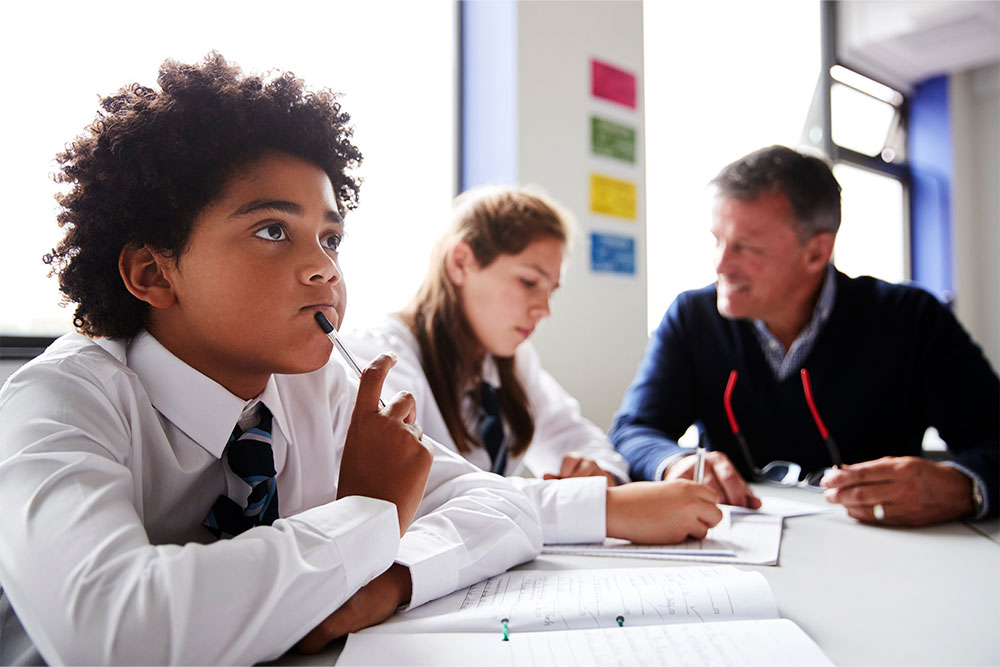
What is metacognition? My tutor asked this during teacher training. Thrown out moments after grappling with his own explanation for a painful (and baffling) 60 seconds.
I knew this one. So, I regurgitated the one sentence that had stuck from the assigned reading: It’s thinking about thinking.
Great, yes, correct – now let’s move on.
Why was a teaching method proven to help learners, practically free to implement and relevant to every subject, almost ignored?
Because most teachers don’t really understand metacognition, let alone how to use it to help children learn.
If you want to level up your teaching with metacognition, this guide is for you. It gives you a useable definition of metacognition in education, the benefits and practical strategies, with plenty of worked examples. (One of the hallmarks of an effective metacognitive approach.)
What is Metacognition?
Describing metacognition as thinking about thinking isn’t wrong. It’s just unhelpful and irrelevant to pedagogy. A better definition is pupils thinking about their learning in terms of what’s going well and what can be done better.
Take two students – one with a handle on metacognition and one without. Deliver the same lecture to both and the results will be very different.
One learner will actively listen, checking in with themselves periodically to test their understanding. If anything isn’t clear, they’ll ask you questions to clear up the confusion. This is a metacognitive approach to learning.
The other learner will remain passive, settling with a tenuous grasp of the material, unaware of anything they can do to improve their understanding.
And this isn’t a simple case of effort. Learners struggle with tasks because they don’t know how to determine why something’s hard (a lack of metacognitive knowledge) or what they can do about it (weak metacognitive regulation).
Metacognition Knowledge
Metacognitive knowledge is what a learner knows about learning. There are effectively two parts to this:
- What the learner knows about themselves.
- What the learner knows about the task.
Think about how a pupil might approach a maths problem, for example.
A child with good metacognitive knowledge might consider:
- Their abilities (e.g. I’m not confident with numbers)
- Their understanding of the task (e.g. I recognise this type of problem)
- Their knowledge of available strategies (e.g. I can use subtraction to solve it)
Metacognition Regulation
Metacognitive regulation is putting knowledge into action. Learners should evaluate their success when tackling a task and change tactics if they struggle. Returning to our previous example, the learner recognises that maths is tricky for them but is aware of a strategy to solve it – using subtraction.
The learner attempts to solve the problem but grapples with the answer. They recognise that their subtraction strategy isn’t working, so they try a different approach, possibly using formal column subtraction as they’ve found it easier in the past. This change of tactic is metacognitive regulation.
Cognition and Metacognition
Metacognition is one part of self-regulated learning. It’s knowledge of personal strengths, weaknesses and success in a task. But children with this self-awareness still need a deep bench of strategies to choose from when they’re struggling, which is where cognition comes in.
Cognition refers to the actual subject-specific skills required to perform a task. For example, using different methods to subtract a number.
So, cognition and metacognition have to work together. If you teach children multiple strategies for a learning task, they can reflect on and select the best one for them as learners.
Metacognition Benefits
Metacognition in education is proven to help children and young people learn. The Education Endowment Fund (EEF) compiles evidence of the effectiveness of different teaching strategies and ranks metacognition as one of the best. According to the EEF, metacognition helps learners make an average of an additional seven months of progress.
Metacognitive approaches are also particularly beneficial for disadvantaged learners and practically free to implement. (Take the strategies outlined below; none require additional resources.)
But you can only realise these benefits if you understand and apply the concept to your everyday practice.
Metacognitive Strategies
Weave it into Lessons
Some educators treat metacognition as a subject, teaching metacognitive approaches in dedicated lessons. This approach misses the point. To develop metacognitive abilities, learners need a task to apply them to. It can be anything in the curriculum – from academic to creative tasks.

But don’t feel you need to be subtle. Talking explicitly about metacognition and encouraging discussion helps learners develop their skills
Teach Pupils how to Plan, Monitor and Evaluate Learning
There are three phases to successful learning following the metacognitive framework:
- Planning – Before starting a task, students must think about the learning aim and decide on a suitable approach guided by past experience.
- Monitoring – As students undertake the task, they should check progress towards the stated learning aim and change strategy accordingly.
- Evaluation – Students must compare outcomes against the learning aim after finishing the task. The results will inform future attempts to tackle similar activities.
Applying this process to our maths problem example, a learner might go through these stages:
Planning – This question is presented as a word problem, and I’ve previously struggled with this kind of question. But, I know that highlighting the key information helps me. I also understand that words like ‘less than’ usually mean I must use subtraction.
Monitoring – I’ve written it out as a subtraction problem and the numbers make sense. I think I can solve it. If unsure, I can check my answer using the inverse operation.
Evaluation – I’ve found the correct answer. So, now I know that I’ll need to use subtraction whenever I encounter word problems like this.
Talking through problems with others also helps you find solutions and gain perspective.
Model Your Thinking
Every teacher uses modelling to explain tasks and demonstrate necessary skills. But don’t stop there. You can use the same approach for teaching metacognition.
Looking back at the previous section – plan, monitor and evaluate – a learner won’t know to do that unless you show them what each stage requires.
Work through a task and say aloud the questions and answers you’d want learners to mirror while they work independently. Make it clear that what you’re doing helps learning and is something they should emulate.
Make Work Sufficiently Challenging
Modelling your thinking is integral to teaching metacognition but can go too far. Children miss out on opportunities to think for themselves if you give them a precise script to follow and you work through every example. Always leave space in your lessons (or sequence of lessons) for independent practise.
But you’ve got to find a balance. Learners quit if they think something is beyond them. They also quit if something’s too easy. You need to find a sweet spot that’s challenging enough to motivate a learner (and help them embed the cognitive strategies taught) without making them feel hopeless.
Developing Your Own Skills
Teachers teach, but it’s also vital for them to learn. Professional development outside the classroom gives you new skills that help your practice. One area teachers consistently struggle with is self-care.
Our online mental health courses offer a range of practical strategies to manage your well-being and cope with the stresses of full-time teaching. Every course is online and accessible on your schedule, so you can fit them into even the busiest timetable. You’ll be able to develop resilience, protect your mental health, and step back into the classroom as the best version of yourself.






















